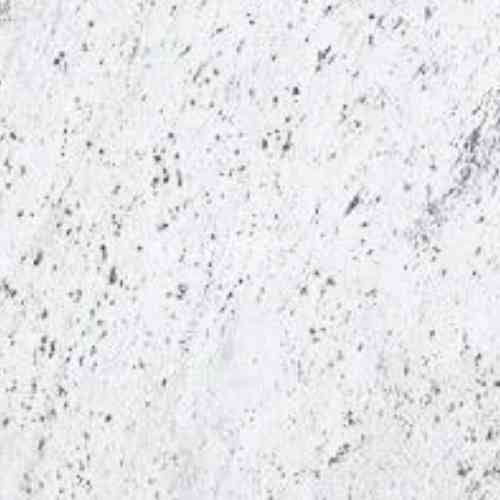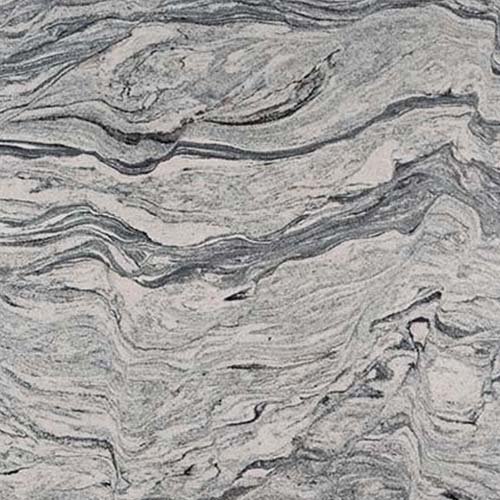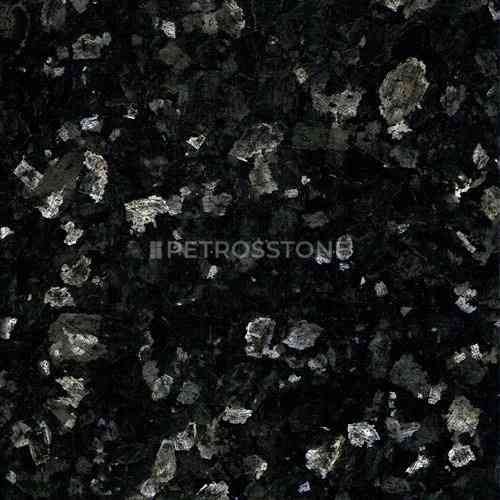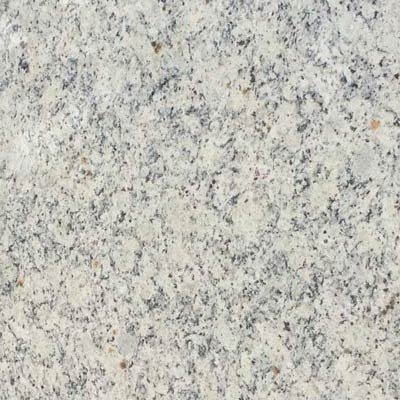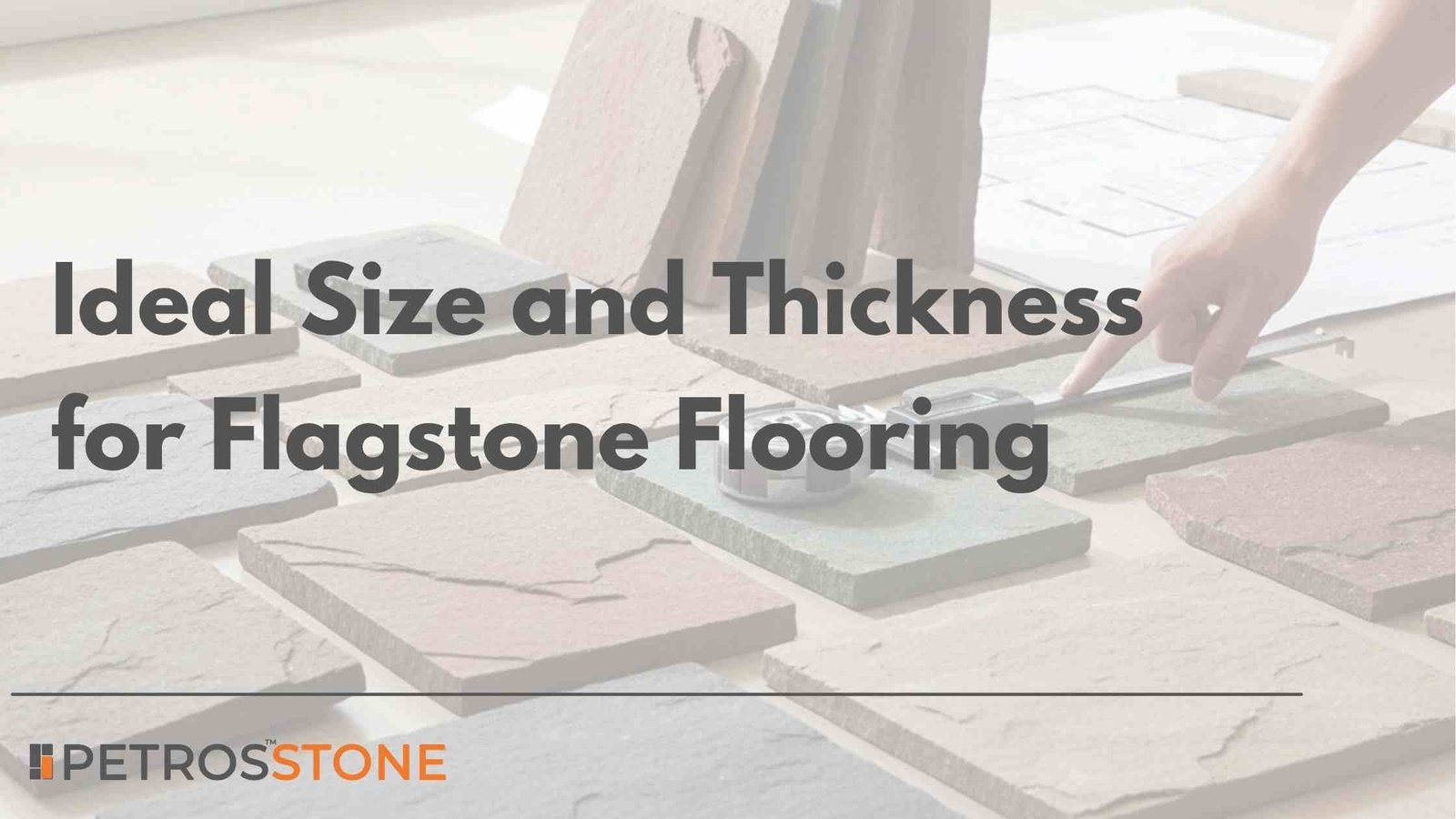
Ever walked barefoot over a stone patio and felt nature itself beneath your feet? That cool, uneven yet soothing surface carries a timeless charm — as if each stone holds centuries of untold stories. This is the unique magic of flagstone flooring.
Unlike manufactured tiles or concrete pavers, flagstones connect your space to the natural world in the most authentic way. Their raw beauty, earthy textures, and irregular shapes offer a grounding experience that no factory-made material can match.
But here’s the truth: not all flagstones are created equal. The patterns, sizes, and design you choose will significantly impact the final look, durability, and performance of your flooring. From load-bearing strength to aesthetic harmony, the flagstones’ dimensions and thickness will determine how well your patio or walkway holds up, both visually and structurally over time.
Common Flagstone Dimensions
| Category | Size Range (Inches) | Typical Use |
|---|---|---|
| Small Pieces | 6″ – 12″ | Borders, detailed accents, small stepping stones, or tight-curve walkways. |
| Medium Pieces | 12″ – 24″ | Standard paving, patios, walkways, and areas with moderate foot traffic. |
| Large Pieces | 24″ and above | Large open areas, dramatic patios, focal points, and areas requiring minimal jointing. |
Flagstone Thickness Guide
| Application | Recommended Thickness | Key Consideration |
|---|---|---|
| Indoor Flooring | 1/2″ to 1″ (approx. 12mm to 25mm) | Adequate for residential floors over a concrete slab or subfloor. Requires mortar. |
| Outdoor Patios/Walkways (Mortar-Set) | 1″ to 1.5″ (approx. 25mm to 38mm) | Strong enough for furniture and foot traffic over a concrete base. |
| Outdoor Patios/Walkways (Dry-Set) | 1.5″ to 2″ (approx. 38mm to 50mm) | Needed for gravel/sand base to prevent cracks from shifting and heavy use. |
| Driveways/Heavy Vehicle Traffic | 2″ to 3″ (approx. 50mm to 75mm) | Recommended only for heavy-duty use; needs a reinforced base for support. |
In this article, we are going to take you through all you need to know about flagstone dimensions, including standard size and a range of thicknesses, advantages and disadvantages, costs, colors and some of their installation advice.
- What is Flagstone Flooring?
- Why Size and Thickness Matter in Flagstone Flooring?
- Standard Flagstone Sizes and Thicknesses
- Flagstone Applications
- Pros and Cons of Different Sizes of Flagstone
- Estimated Cost of Flagstone Flooring
- How to Choose Flagstone Flooring?
- Installation Tips
- Maintenance – Keep it looking Good
- Where to Buy?
- Summary
- FAQs
- Key Takeaways
What is Flagstone Flooring?
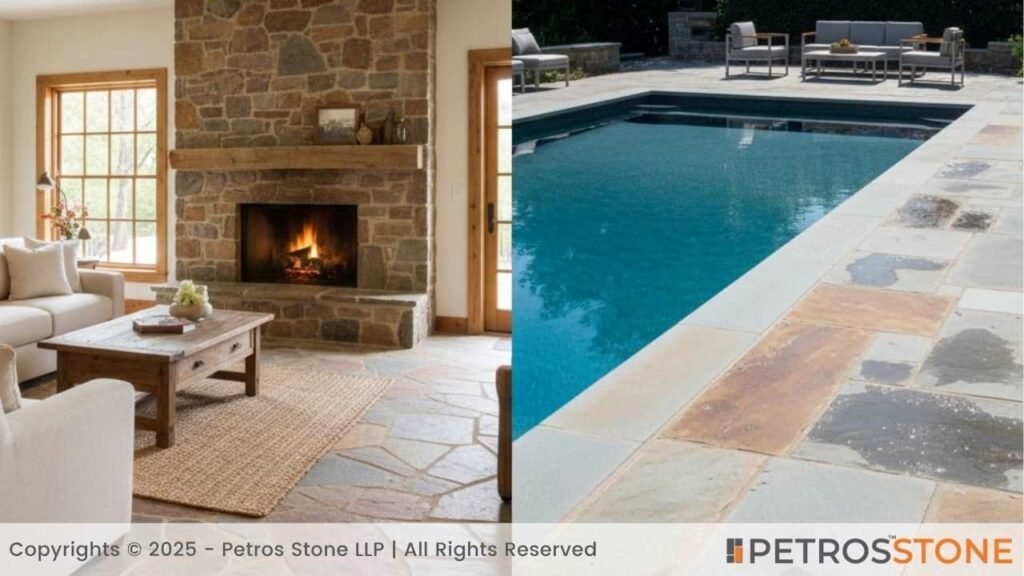
Flat, split blocks of natural stone and typically sedimentary rock, such as sandstone, limestone, or bluestone are referred to as flagstone. In contrast to tile cutting which is perfect, flagstones are with uneven cut, which creates a more natural and organic appearance.
For flooring, the flagstone is adored on account of its versatility. It may either be installed inside or outside, in detailed mosaics, or simple with huge slabs to create a contemporary look. It is sturdy, non-slippery (its natural texture is the reason), and it comes in a variety of earthy colors. These attributes ensure that it is one of the most favored patio, pathway, pool deck and rustic indoor flooring.
Why Size and Thickness Matter in Flagstone Flooring?
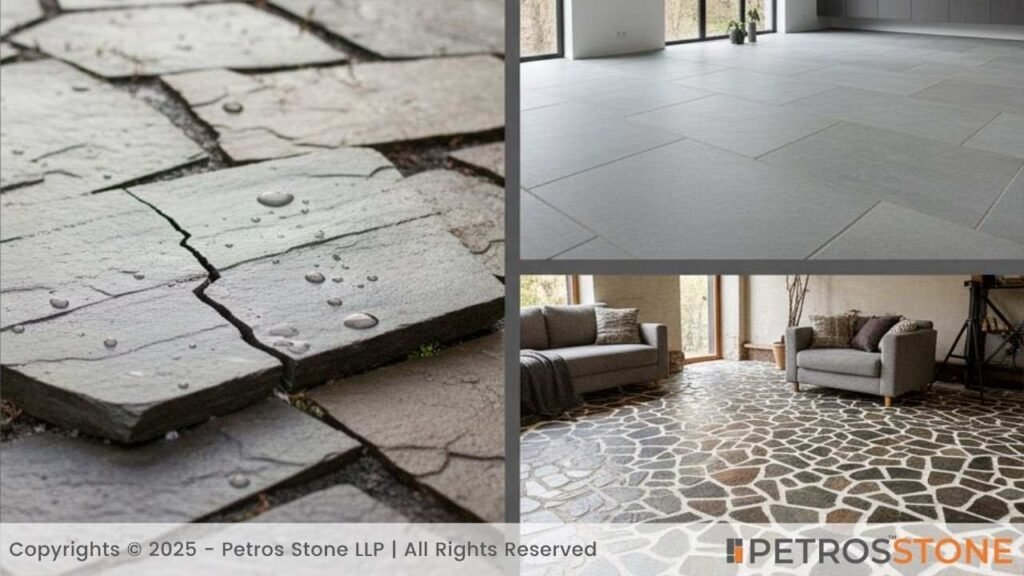
Color and price are some of the factors that people consider in the purchase of stone. But size and thickness is what makes or breaks your flagstone floor.
Thickness is important as it regulates strength and stability. Stone that is too thin can easily crack under weight especially when it is outside where temperatures vary and moisture is a factor.
On the other hand, the size is important as it determines aesthetic and the aspect of being easy to install. Big stones produce a smooth, minimal appearance and have less seams compared to small pieces, which are more mosaic in appearance.
The way to think about it is that flagstone picking is the same as picking shoes. The wrong decision however, could soon become a disappointment.
Standard Flagstone Sizes and Thicknesses
Flagstone isn’t sold like ceramic tiles with strict measurements. Instead, you get ranges of size and thickness because the stones are split naturally. Still, there are some standard guidelines to help:
Standard Flagstone Sizes
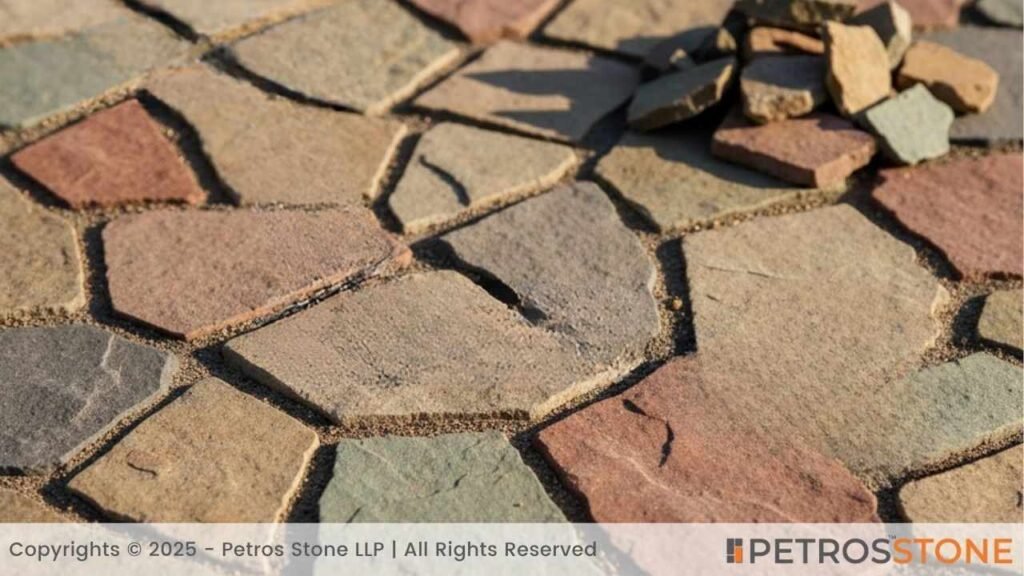
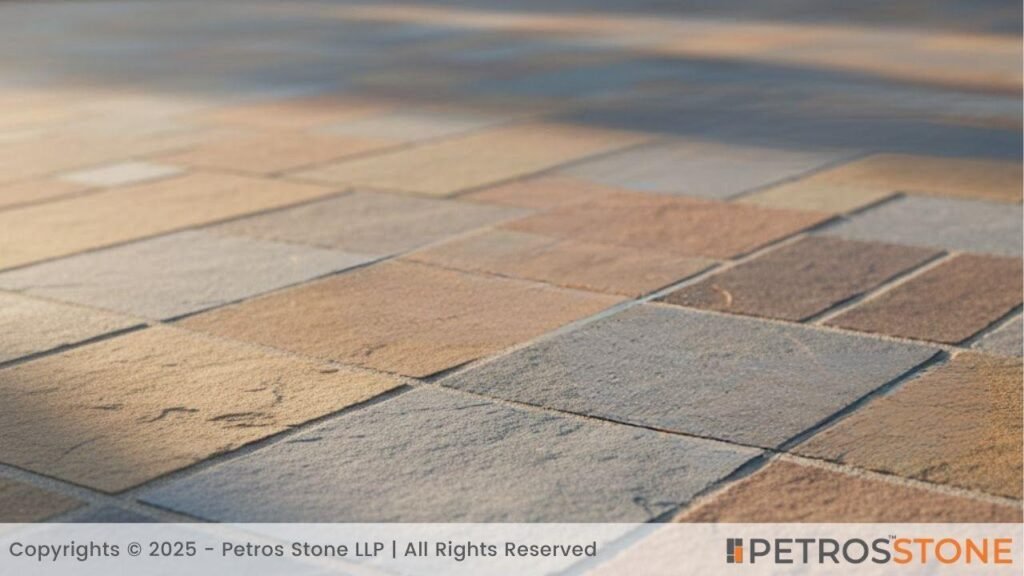
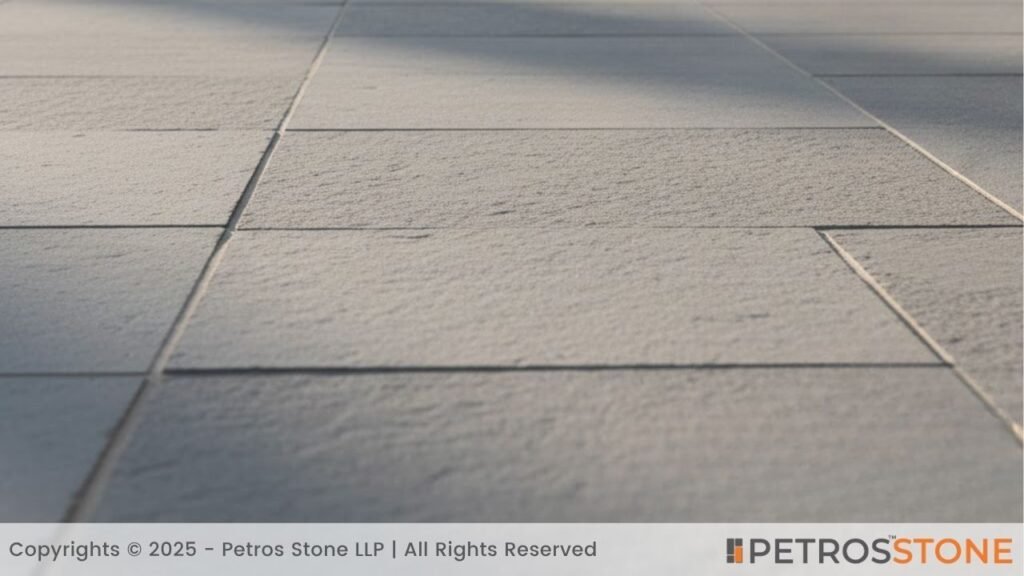
Common Sizes of Flagstone
| Category | Size Range (Inches) | Typical Use |
|---|---|---|
| Small Pieces | 6″ – 12″ | Borders, detailed accents, small stepping stones, or tight-curve walkways. |
| Medium Pieces | 12″ – 24″ | Standard paving, patios, walkways, and areas with moderate foot traffic. |
| Large Pieces | 24″ and above | Large open areas, dramatic patios, focal points, and areas requiring minimal jointing. |
Standard Flagstone Thicknesses
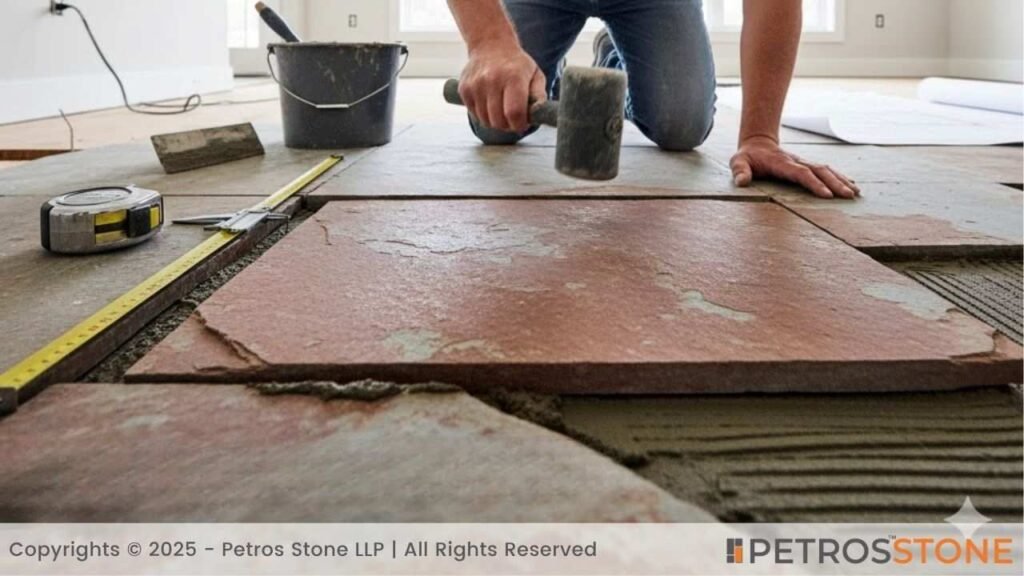
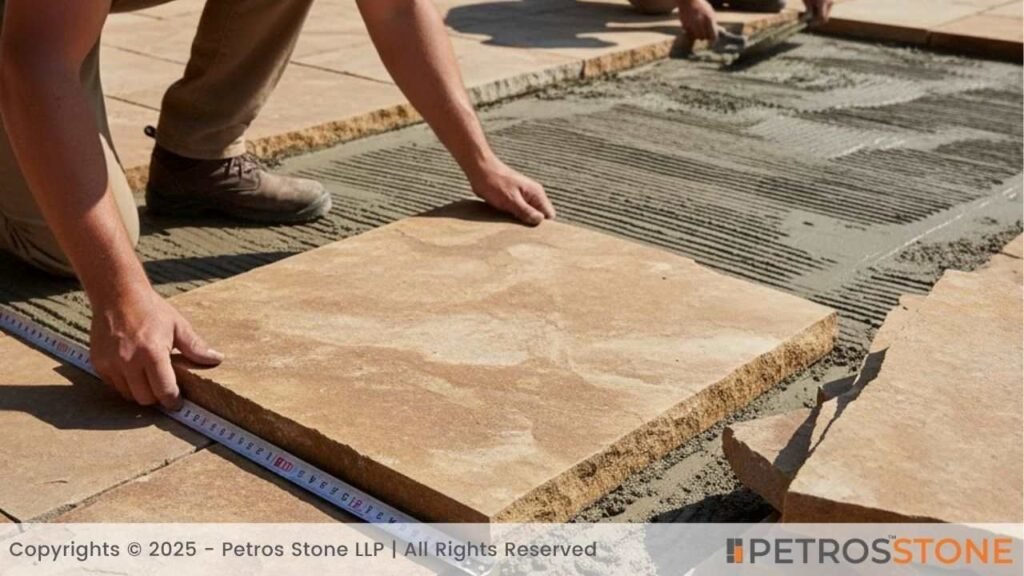
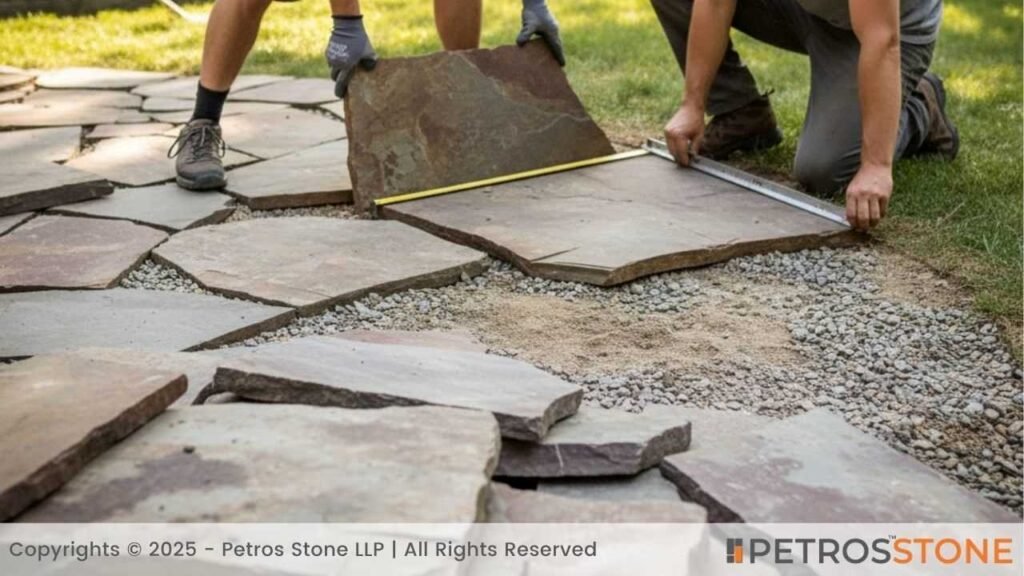
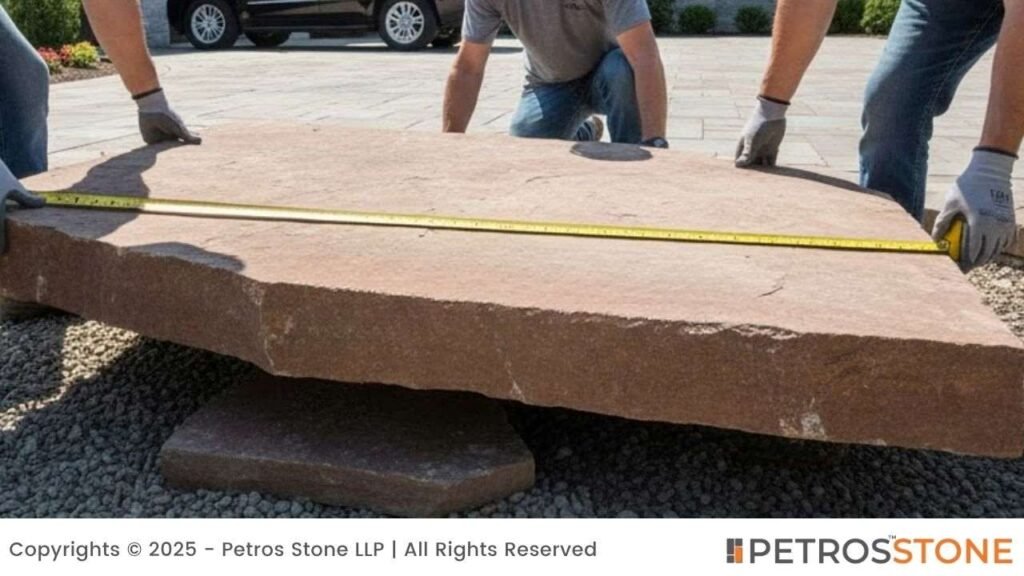
Flagstone Thickness Guide
| Application | Recommended Thickness | Key Consideration |
|---|---|---|
| Indoor Flooring | 1/2″ to 1″ (approx. 12mm to 25mm) | Adequate for residential floors over a concrete slab or subfloor. Requires mortar. |
| Outdoor Patios/Walkways (Mortar-Set) | 1″ to 1.5″ (approx. 25mm to 38mm) | Strong enough for furniture and foot traffic over a concrete base. |
| Outdoor Patios/Walkways (Dry-Set) | 1.5″ to 2″ (approx. 38mm to 50mm) | Needed for gravel/sand base to prevent cracks from shifting and heavy use. |
| Driveways/Heavy Vehicle Traffic | 2″ to 3″ (approx. 50mm to 75mm) | Recommended only for heavy-duty use; needs a reinforced base for support. |
Flagstone Applications
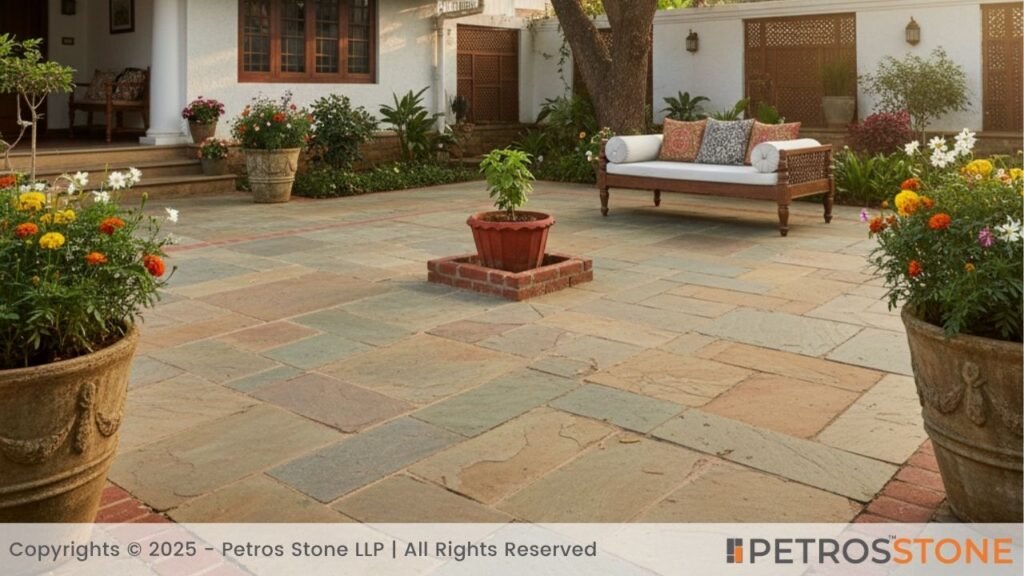
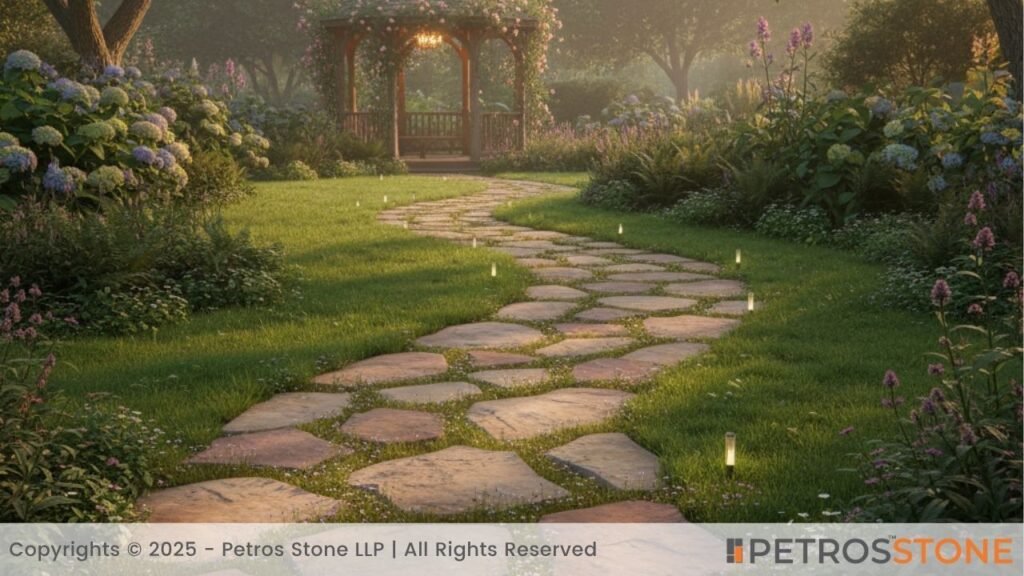
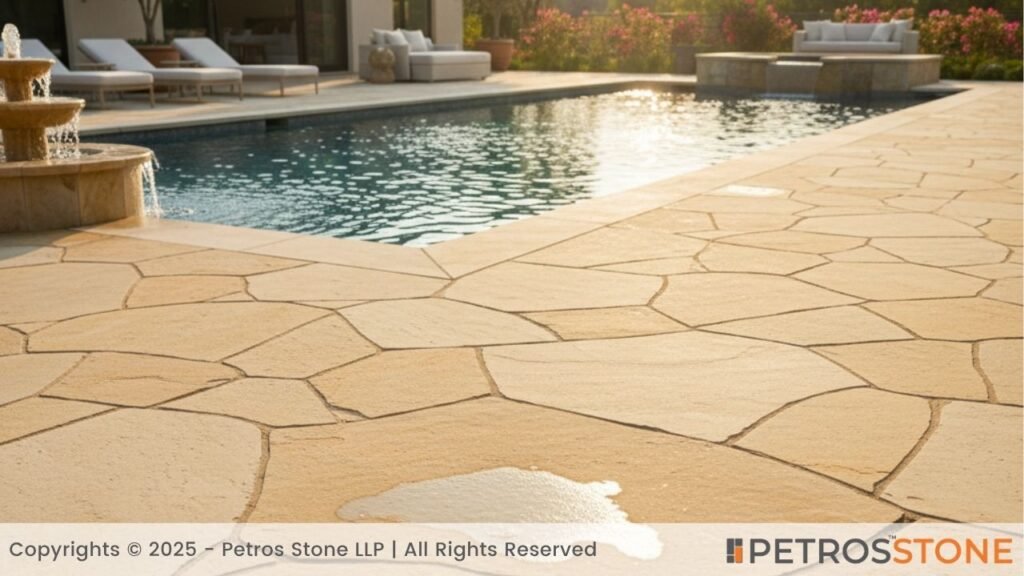
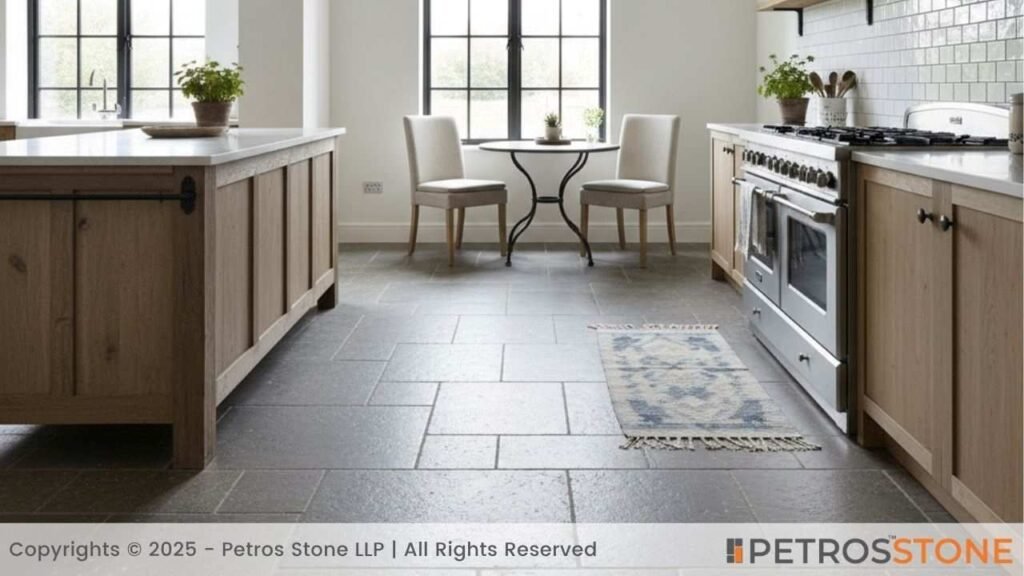
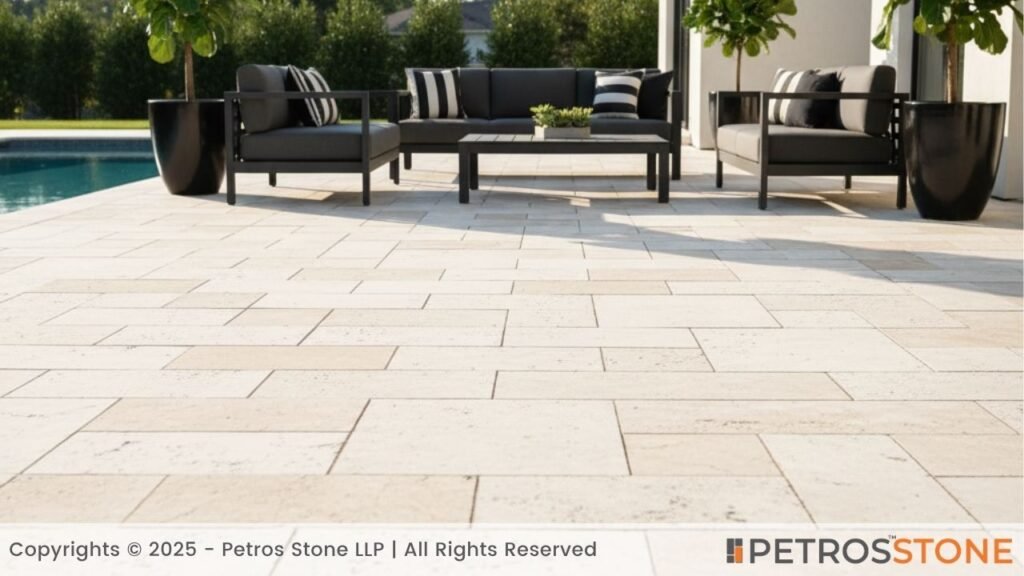
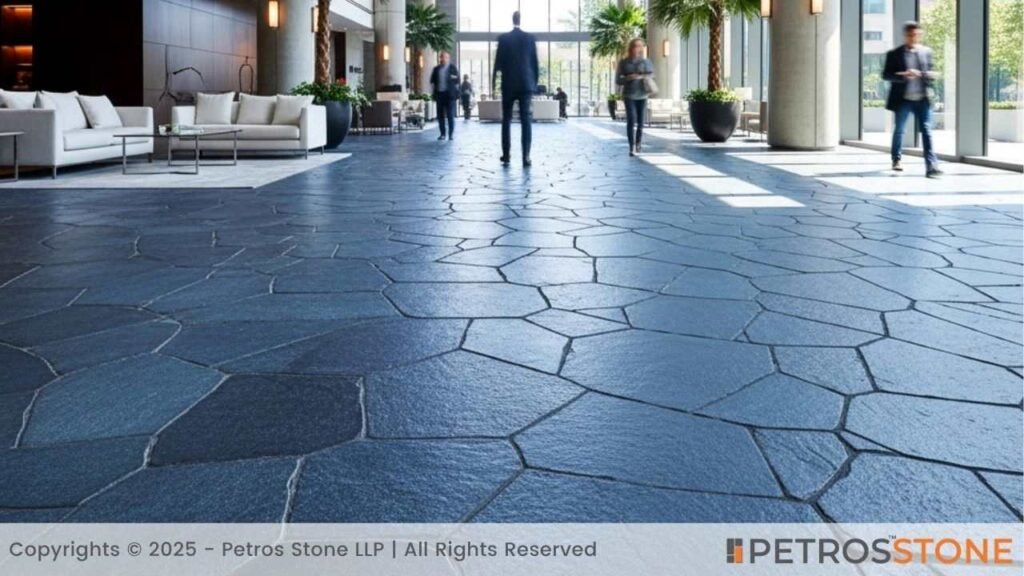
- Patios and outdoor seating areas
- Garden pathways and stepping stones
- Driveways and courtyards
- Pool decks and pool coping
- Outdoor kitchens and BBQ spaces
- Retaining walls and garden edging
- Steps, stairways, and landings
- Fire pit surrounds
- Interior flooring in rustic or modern homes
- Wall cladding and accent walls
- Landscaping features and decorative borders
Pros and Cons of Different Sizes of Flagstone
Small flagstones (6″–12″)
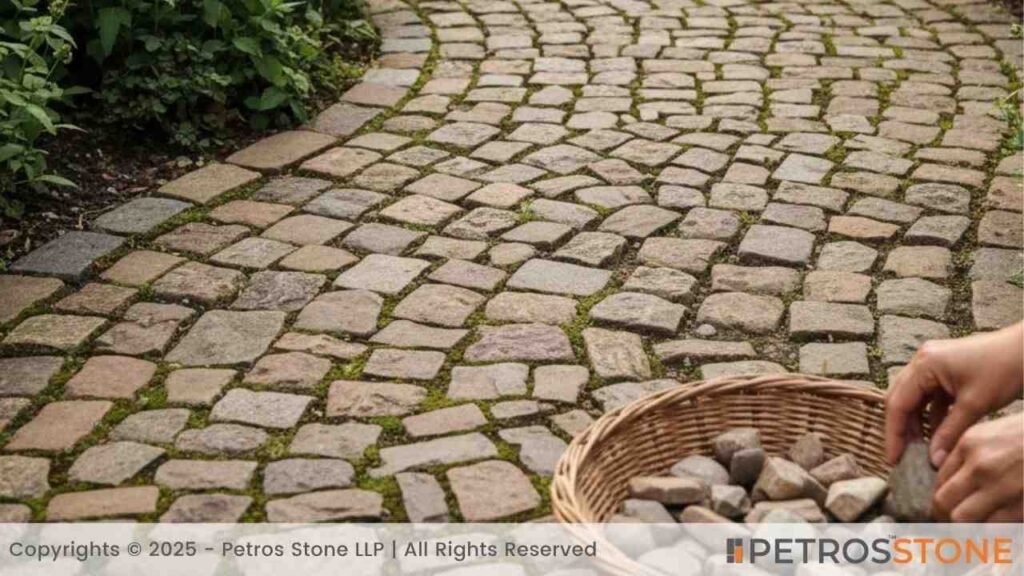
Pros
| Flexible for curved layouts | Small flagstones easily adjust to bends, curves, or winding paths. Perfect for gardens and irregular designs. |
| Easy to lift and install | Lightweight and simple to handle. Ideal for DIY projects — no need for heavy equipment or professional help. |
| Budget-friendly | Smaller stones cost less than larger slabs and lower installation costs due to easier handling and reduced labor. |
Cons
| Too many joints | More pieces mean more grout lines, which can trap dirt and weeds. Regular cleaning and maintenance are required. |
| Can look messy | Without careful arrangement, the layout may appear cluttered or uneven, which affects the aesthetic appeal of the area. |
Medium Flagstones (12″–24″)
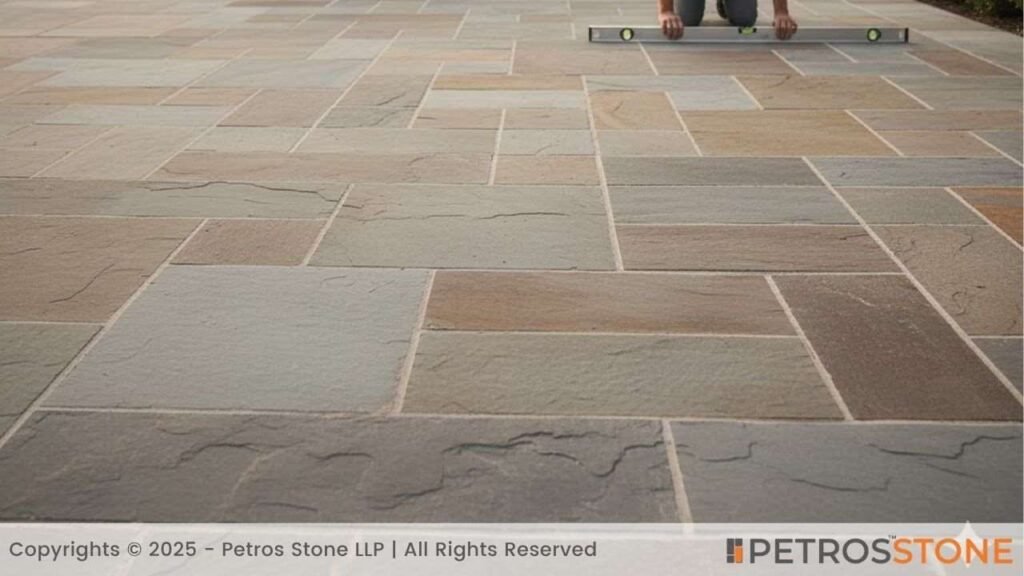
Pros
| Balance of looks and function | Not too small to look cluttered and not too large to be unmanageable. Works well in almost all types of patios. |
| Easier installation | Moderate size makes them easier to move compared to large flagstones, reducing installation effort while providing a solid surface. |
| Classic and timeless | Used for decades, medium-sized flagstones blend well with traditional gardens and modern homes, offering versatile aesthetics. |
Cons
| Requires careful leveling | Uneven placement is more noticeable than with small stones, so extra care is needed to keep the surface flat. |
| Patterns may take time | Designing a neat and attractive layout with medium stones can be time-consuming and requires planning. |
Large Flagstones (24″+)
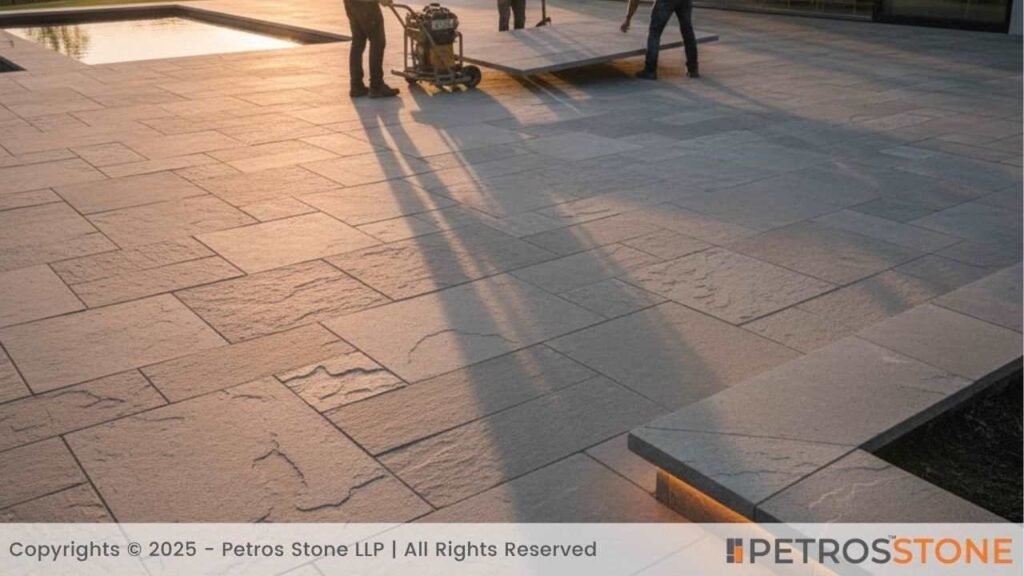
Pros
| Stunning modern appearance | Big slabs give a clean, bold, and luxurious feel. Ideal for contemporary patios with a sleek, minimal look. |
| Minimal joints | Fewer gaps between slabs make cleaning easier and the surface stays neat and uniform. |
| Great for sleek patios | Perfect for wide, open patios or modern gardens. The large size makes the area appear spacious and uncluttered. |
Cons
| Very heavy | Handling large slabs is challenging and usually requires professionals. Lifting and installation without help is nearly impossible. |
| Expensive and harder to cut | Large flagstones cost more due to size and durability. Cutting or shaping requires special tools and extra labor. |
Estimated Cost of Flagstone Flooring
The cost of flagstone varies based on stone type, thickness, and installation.
Material cost: $3 – $20 per sq. ft.
Installed cost: $12 – $40+ per sq. ft.
For example: A 200 sq. ft. sandstone patio might cost around $4,600 fully installed.
Factors affecting cost:
- Stone type (sandstone cheaper, bluestone & quartzite expensive).
- Thickness (thicker stones = more cost).
- Installation method (sand-set cheaper, mortar-bed expensive).
- Location (delivery and availability).
How to Choose Flagstone Flooring?
When you are choosing a flagstone flooring, you need to think of the decision as practical + stylistic:
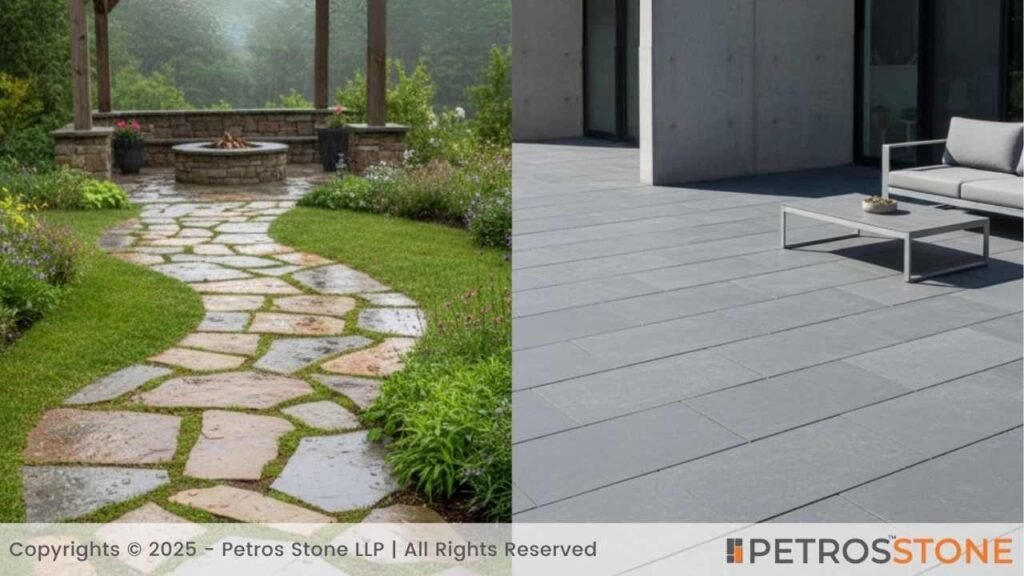
- Use & Load – The first thing to consider is where you will use. Foot traffic only garden path or patio can get away with thin stones. However, due to steps, driveways, or where cars and heavy items are to be, use heavy flagstone.
- Climate– In case you live somewhere with extreme winters or lots of rain, the frozen and thawing of thin stones may be broken. Stones of a proper drainage are thicker in such places and have a long life.
- Style – do you prefer a natural and earthy finish or a clean and modern touch? The shape of the stones is irregular and organic and the stones that are cut and sawn create a smooth and elegant look. choose your style of home.
- Budget – Flagstone may be cheap or expensive depending on the type and the thickness. It is important to remember that, not only are heavier and high-end stones more expensive, but they also make installing them higher. Plan wisely.
- Maintenance Tolerance – Without minding cleaning and sealing, you can go on lighter shades which look nice but reveal stains without difficulty. To have a low-maintenance option, a darker stone would conceal the markings, and stay tidy longer.
- Installation Type– Dry laid and sand-set stones are easier and less expensive to install. Strong, polished, but requiring professional masons and greater preparation are mortar slabs or anchored slabs.
- Plan Ahead – It is good to walk round your space, or draw a rough plan before you purchase. This little move will assist you to concisely talk to the suppliers about ideas and prevent confusion in the future.
Installation Tips
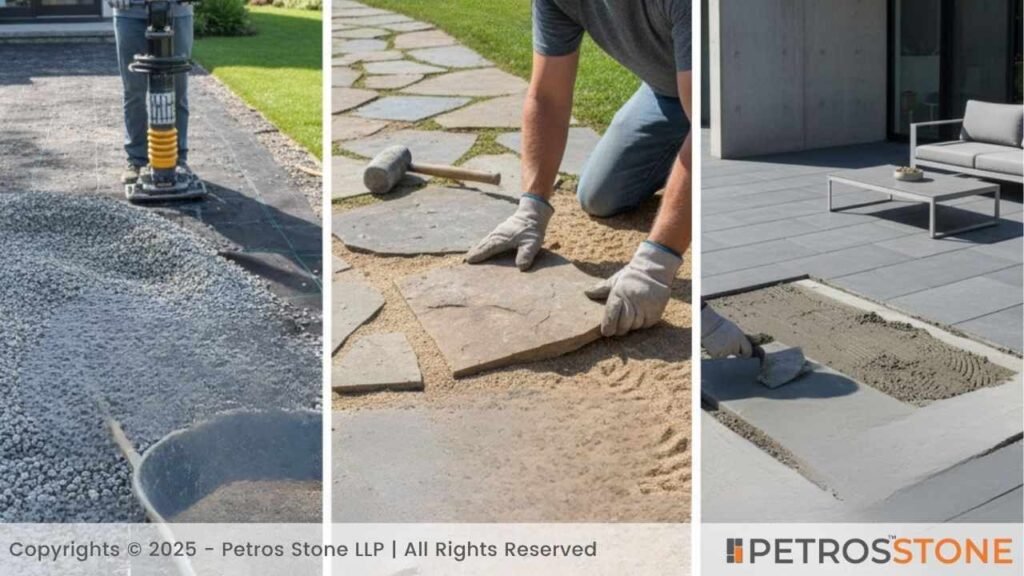
- Prepare the Base – To pave patios or walkways where foot traffic only is required, tamp a layer of crushed stone 46 inch thick. Should it be a driveway or an area that cars will cross, then make the base thicker- 8-12 inches with adequate compaction.
- Add Geotextile Fabric -Where there is drainage trouble or loose soil, put down a geotextile fabric beneath the base. This prevents mixing of soil and the stone and makes the foundation stable.
- Select Sand or Mortar Setting
Sand-Set (Dry Lay) -Place stones on 1 inch bedding sand. It is easy, patio friendly and it is easier to substitute the stones in the future.
Mortar- Bed (Wet Set)- Set the stones laid on a concrete base using mortar. It is more rigid and should be used in the interior environment or in outside surroundings that need to remain at all times level.
- Mind Drainage & Expansion– There should be a constant slope of 1-2% away the buildings to ensure the water drains. Add large areas with expansion or flexible joints to avoid cracking.
- Install Edge Restraints -Install metal, concrete or stone edging to prevent the flagstones sliding sideways with time.
- Seal the Surface –Seal the stone using a penetrating sealer to prevent stains, particularly on lighter stone and where the stone is close to an outdoor kitchen/BBQ. Reseal once a year to three years depending on weather and traffic.
- Tools of the Trade – Have on hand a wheelbarrow, plate compactor, rubber mallet, trowel, masonry saw or angle grinder with diamond blade, level, and straightedge to cut, flatten and install.
Maintenance – Keep it looking Good
- Do it Eeveryday: Clean up or wipe out debris.
- Stains: Blot and wash with weak detergent; harsh acids are not used on calcareous stones (limestone).
- Sealing: Penetrating sealers block oil and water; topical sealers alter finish (gloss) and can need additional maintenance.
- Care in winter: shovels made of plastic should be used, no rock salt should be used on sensitive stones, and pet-safe ice melts may be used.
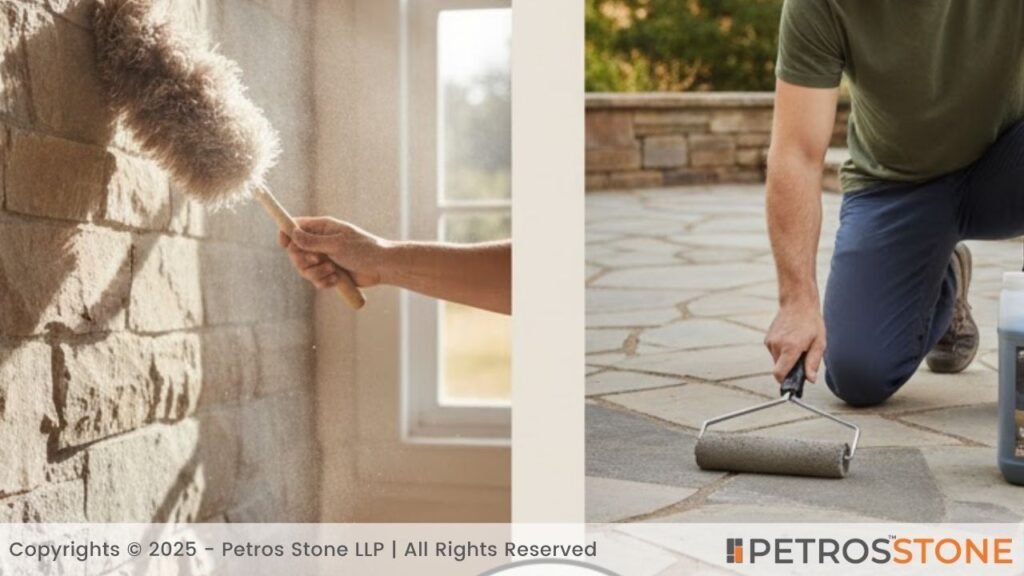
Where to Buy?
When it comes to purchasing flagstone, there are different alternatives that you can choose based on your requirements. Stone yards and quarries are localized, and you can see the entire slabs up at the local ones, and get matched batches to look even. Specialty landscape suppliers usually offer pre-formulated packages that can be used in the patios and walkways, and thus the process of choosing becomes easier.
Moreover, home improvement stores are also easily accessible and normally stock the most popular ones. Online stone marketplaces may be useful with rare types or bulk orders though, remember to order samples first before making large orders.
Another alternative is reclaimed stone yards which are available at a reasonable price and have a distinctive character though they are hard to pick. If you’re looking for a trusted source, Petros Stones offers a wide range of flagstone options with competitive prices and quality materials.

Tip: Ask for pictures of the specific batch and, if possible, visit the yard to inspect actual pieces. Colors and veining vary even within the same “type.”
Summary
Now you are aware that the use of flagstone flooring offers elegance, durability as well as naturalness that you cannot replicate with manufactured tiles. The size and the thickness count every bit towards its duration of life and the amount of maintenance required. think use, climatic, and budget. You can never go wrong with a little more thickness and you will be safeguarding both your stone and your wallet in the long run.
For more information, you can connect with the experts using the below mentioned correspondence!
FAQs
Q: What is the thickness of flagstone supposed to be?
A: On the majority of patios and walkways, target 1″ -1.5 (25-38 mm). On heavier loads or bad bases, take 1.5 -2.5″ (38-65mm) or even heavier.
Q: What is the thickness of flagstone flooring to use indoors?
A: Flagstone placed indoors, usually on a concrete slab, may utilize 3/4 -1.25″ (20-30 mm) sawn tile, or1-1.5″ when placed in mortar, to provide continuity and strength.
Q: How large, on the average, is flagstone?
A: Flagstone is irregular, although standard utilizable sizes are 6in. -24in. Sellers tend to call work small, medium or large instead of specific sizes.
Q: What should be the thickness of stone flooring on the whole?
A: When using natural stone flooring on a structural slab, the standard range is between 3/8-3/4 inches on thin tiles, however, when using true flagstone and at the exterior, a range of 1-2.5 inches is practical depending on the load.
Key Takeaways
- The flagstone flooring is strong, natural, and provides classic beauty to a given place.
- Thickness is important – 1″-1.5″ would be good in patios, and 2+ in heavy applications such as driveways.
- Size matters – small sections fit the curves, medium sizes fit patios, and the large slabs are modern.
- The most important thing is to make a good base and have drainage so that the foundation does not crack or shift.
- Covering your flagstone and cleaning it frequently preserve the different shades, which are light.
- Get quality, varieties and reasonable prices of stones through suppliers whom you can trust such as Petros Stones.
Feel free to get in touch for a free consultation, quote, and get a detailed understanding from our experts here at Petros®. Visit https://petrosstone.com/ or call +91-8446360361 and WhatsApp

Hello!
I’m Varsha, with a deep interest in architecture and years of content writing experience, I explore how natural stones like granite and marble shape beautiful, functional spaces. At Petros® Stone, I share insights that help readers appreciate the design potential and timeless appeal of stone.
Brown Granite
White Galaxy Granite
Blue Bahia Granite
Silver Cloud Granite
Black Pearl Granite
Dallas White Granite


